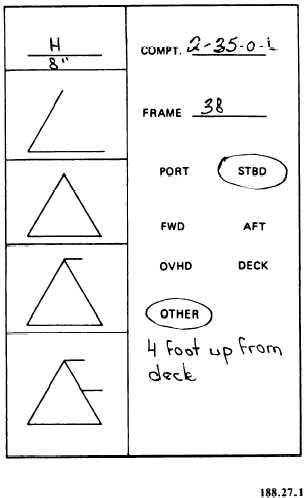Chapter 2—ADMINISTRATION, SUPERVISION, AND TRAINING
procedures not only between adjoining spaces but
also between watch sections within the same
space.
The posted operating instructions often do
not apply to the installed equipment. They were
conflicting or incorrect. No procedures were pro-
vided for aligning the various systems with other
systems.
The light-off and securing schedules were
prepared by each ship and were not standardized
between ships. The schedules were written for
general, rather than specific, equipment or system
values and did not include shifts between all the
existing modes of operation.
Figure 2-18.—Preprinted message format.
of these studies have shown that in many instances
sound operating techniques were not followed.
Some of the circumstances found to be prevail-
ing in engineering plants are described below:
Following these studies, NAVSEA developed
the EOSS, designed to help eliminate operational
problems. EOSS involves the participation of all
personnel from the department head to the watch-
stander on watch. The EOSS consists of a set of
systematic and detailed written procedures which
utilize charts, instructions, and diagrams
developed specifically for the operational and
casualty control function of a specific ship’s
engineering plant and configuration.
EOSS is designed to improve the operational
readiness of the ship’s engineering plant by
increasing its operational efficiency, providing
better engineering-plant control, reducing opera-
tional casualties, and extending the equipment
life. These objectives are accomplished by first
defining the levels of control and operating within
the engineering plant and then providing each
supervisor and operator with the information
needed—in words they could understand—at their
watch station.
The EOSS is comprised of three basic parts:
The information needed by the watch-
stander was usually scattered throughout publica-
tions which were generally not readily available.
The User’s Guide
The Engineering Operational Procedures
(EOP)
The bulk of the publications were not
systems oriented. Reporting engineering person-
nel had to learn specific operating procedures
from “old hands” presently assigned. Such prac-
tices could ultimately lead to misinformation or
degradation of the transferred information. They
were costly and resulted in non-standard operating
The Engineering Operational Casualty
Control (EOCC)
EOSS USER’S GUIDE.—The User’s Guide
is a booklet which explains the EOSS package and
how it is used to the ship’s best advantage. It
2-31

